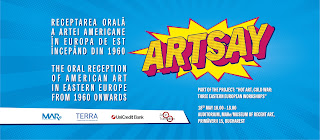ARTSAY. THE ORAL RECEPTION OF AMERICAN ART IN EASTERN EUROPE FROM 1960S ONWARDS

Part of the Project “Hot Art, Cold War: Three Eastern European Workshops” ArtSay. The Oral Reception of American Art in Eastern Europe from 1960 Onwards is a symposium on the alternative reception of American art and visual culture in the mainly (ex) communist, East European Countries, held at MARe/Museum of Recent Art Bucharest, on May 18, 2023. Alternative reception means otherwise than the official, published reception of American art exhibitions either shown in the respective countries or reported to be shown in Europe or elsewhere. The official publications of the time, the specialized art and art history reviews as well as the newspapers and magazines from Eastern Europe usually followed the line of the communist ideology. They were either openly censored or subtly self-censored. On the contrary, the unpublished reception under scrutiny during the symposium ranges from (artists’, but not only) diary entries, passages in private correspondence, recorded memories, goss...

